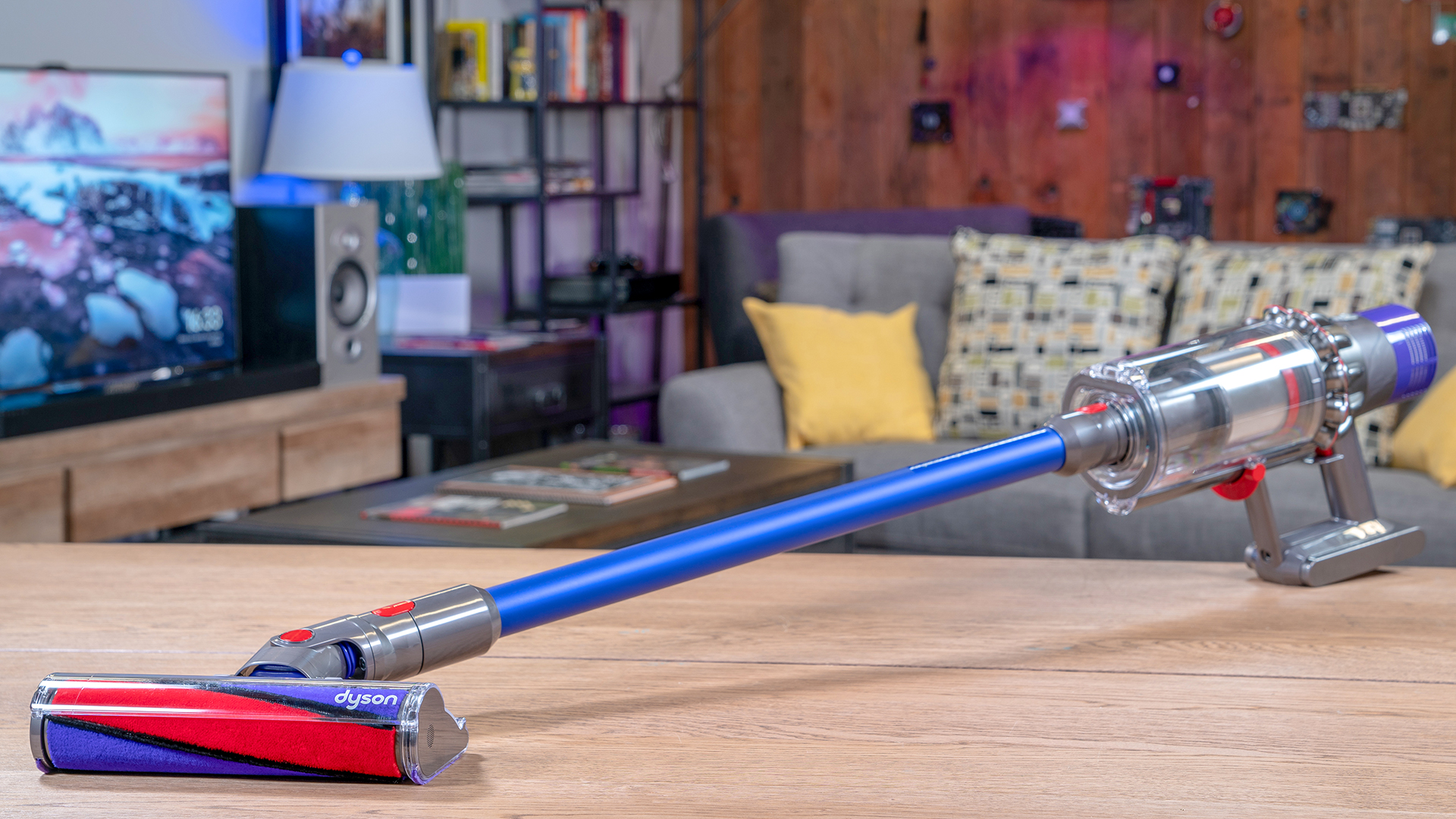
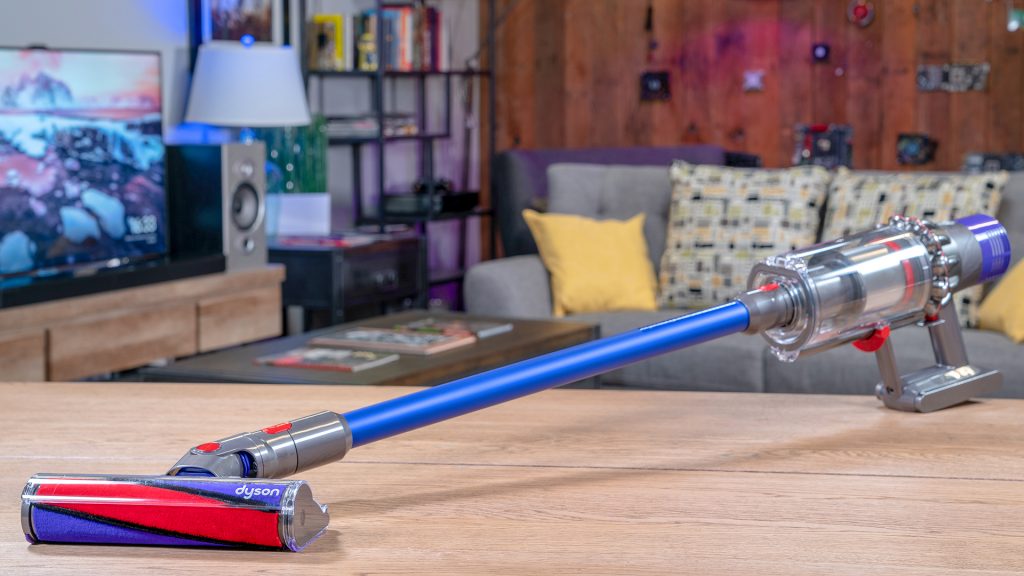
I have a bad history with vacuums. In my freshman and sophomore years of high school, I participated in my school’s work-study program, in which students would perform assigned janitorial duties after school in exchange for pay. I was in charge of vacuuming all the school entrances, lugging my bulky corded industrial vacuum through the halls of my school. Sometimes there wasn’t a plug in sight by some entrances, so I’d have to bring an unwieldy extension cord with me on my excursions (or I would just skip that entrance. I think statute of limitations is up on that one so I can admit it). This experience instilled me with a revulsion for vacuuming, so I think if anyone can appreciate what Dyson has done with their lightest and most powerful cordless vacuum yet, the Dyson Cyclone V10 Absolute, it’s me. I put it to the test to see if Dyson was truly able to balance lightweight design with the strong performance of a full-size vacuum.
The Next Step for an Iconic Brand
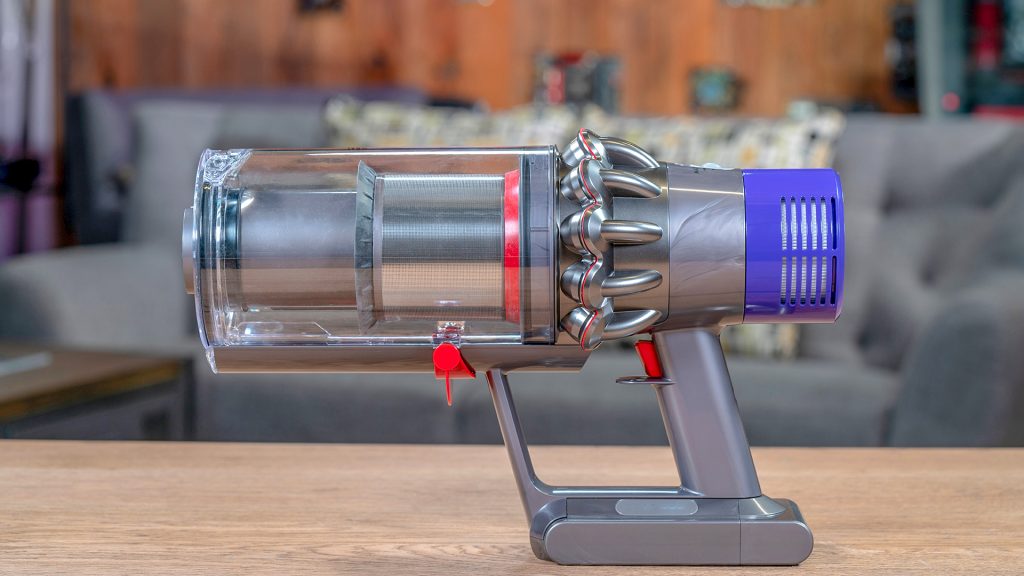
Dyson has been compared to Apple in the past, and in my opinion it’s an apt comparison. Both companies built their brands on the foundation of a strong emphasis on industrial design and engineering, and that emphasis is clear when you look at what Dyson has packed into the Cyclone V10.
Dyson promotes the motor in the V10 as the smallest and lightest, but also fastest and strongest they have ever produced. This motor spins at up to 125,000 rpm and produces 20% more suction than the previous Dyson stick vacuum, the V8. The new motor powers the V10’s 14 cyclones, which generate forces of over 79,000g, flinging microscopic particles like bacteria into the bin.
The smaller motor in the V10 allowed Dyson to revise the design of the cyclone and bin assembly: unlike previous models, the V10 is designed in an in-line configuration, which not only creates a linear airflow path that gives it more suction, but also allows for a front-facing barrel with what Dyson calls a “point and shoot “ emptying mechanism—more on that later.
The battery is another big step up over the previous generation cordless model. The V10 packs in a 7-cell battery—one more cell than the V8—giving it a maximum battery life of sixty minutes, a huge leap when compared to the V8’s forty minute maximum. Each cell is smaller than the cells in V8, so the extra battery doesn’t add any weight to the vacuum. As with any battery-powered tech, the maximum battery life companies promote is under the most optimistic of conditions, and Dyson is careful to point out that the sixty minutes is from using a non-motorized tool at the minimum suction level, and that users should expect lower life depending on the cleaning head and Suction Mode setting. A battery-shaped LED on the V10 displays the battery life, so you’ll know when it’s time to charge it back up.
Dyson has improved the filtration system in the V10, wrapping the pre- and post-filters around the motor as a single sealed unit, capable of trapping 99.97% of particles as small as 0.3 microns. The motor’s housing also produces less noise than previous Dyson stick vacs, thanks to sound-absorbing materials and acoustic baffles added to the design.
The Cyclone V10 comes in three varieties: Absolute, Animal, and Motorhead. The primary difference between the Absolute and Animal is that the Animal does not include a soft roller head cleaner for hard floors. The Motorhead has a smaller bin than the Absolute and Animal, and opts for a direct drive cleaner head instead of the Torque drive head found with the other V10s. For this review, I tested the Blue Cyclone V10 Absolute (also available in copper).
Unboxing and Setup
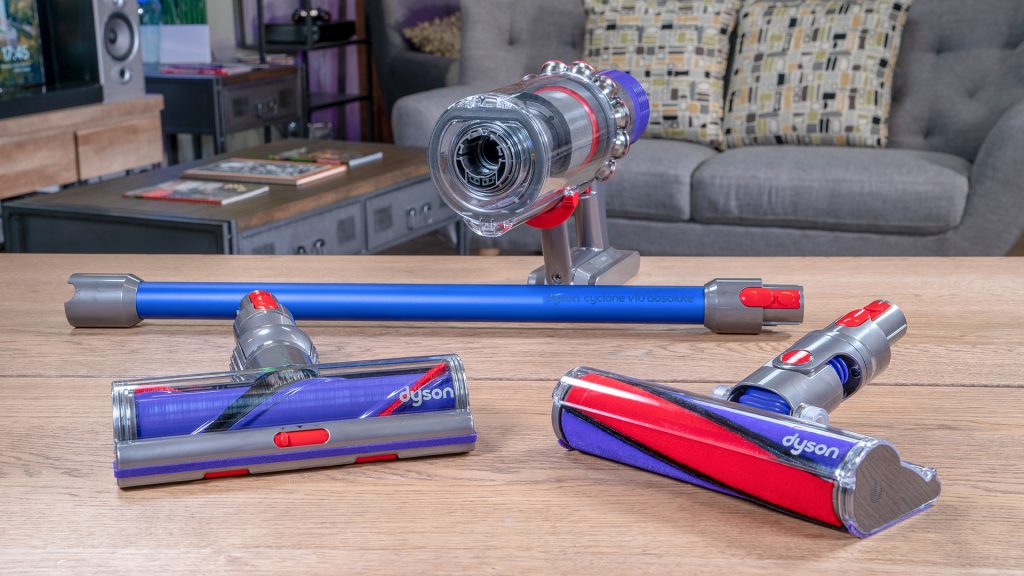
The Dyson V10 Absolute package comes packed to the brim with attachments: the torque driver cleaner head, the primary attachment for cleaning carpet; the soft roller cleaner head, designed for cleaning hard floors; the mini-motorized tool, helpful for upholstery; a crevice cleaning tool; a mini dusting brush for delicate surfaces; and a combination brush and crevice tool.
For charging, the V10 comes with not only a charger, but also a wall-mounted docking station, so you can keep the vacuum in one central location and just hang it up when you’re finished cleaning so it’ll be charged up and ready to go for your next vacuuming session.
Considering the dense amount of contents in the box, I was surprised at the simplicity of setup. After installing the docking station using the included wall screws and plugs, I hung up the V10 and waited for it to charge. Dyson quotes the charging time as 3.5 hours, which was in line with what I saw personally. (Disclosure: the vacuum was previously charged and used for photography purposes, so my experience with the initial charging may differ from the out-of-box experience). When the battery indicator on the unit turns off, the vacuum is fully charged and ready to use.
The Cleaning Test
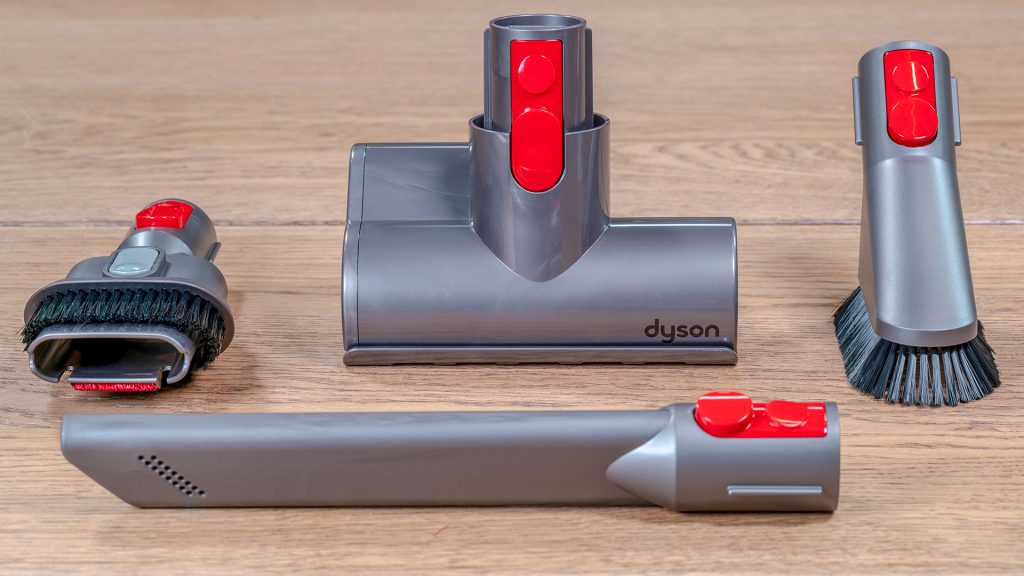
I live in an apartment with hardwood flooring, so I started with the soft roller head attachment. The V10 has three suction power settings, which are controlled via a switch on the top of the vacuum. I started cleaning on the lowest suction setting, since I didn’t notice any particularly troublesome areas of dirt and debris. The vacuum is operated by a soft-touch trigger on its underside; pull and hold the trigger and the V10 quickly comes to life with a space-age whirling sound. When you’re finished cleaning an area, simply let go of the trigger and the vacuum shuts off almost instantly, thanks to the extra magnets and stators Dyson engineers included in the V10. I was shocked by how much dirt the V10 was picking up. Prior to this, I had been broom-cleaning my floors and felt I had been doing a good job; after using the V10, I felt like I was practically living in filth before.
After making a few passes through my apartment—which only took a few minutes, considering I live in a studio—I tried out the torque driver cleaner head for cleaning the area rug in my living room. I have the rug under my coffee table, and it has accumulated its share of crumbs and dirt over time. Swapping attachments was simple: clicking the large red button on an attachment detaches it, at which point you can slide on the next attachment until you feel it click. Attachments can either be connected to the wand or directly into vacuum if you want to use it in handheld mode.
I switched the V10 over to medium suction power since some of the dirt and debris seemed somewhat wedged into my rug. The torque driver head displayed amazing performance, especially at medium suction. Not a crumb was left after only a couple passes over the rug. After cleaning, the rug looked as good as the day I purchased it; I may even wager to say it looked better.
With my floors cleaned, I delved into the other attachments. I decided to break out the crevice tool to work on the corners of the apartment in cased I missed anything with the soft roller. I didn’t pick up much, since the roller seemed to get most of the dirt already, and I don’t have any corners that were hard for it to reach. I found a better use for the crevice tool to be for cleaning behind my entertainment stand, since the tool is small enough to fit down in the gap between the stand and the wall. It was nice to not have to worry about pulling the stand out and risk knocking over my TV or game consoles.
At this point, I saw the bin had almost reached capacity; it was time to try out the “point and shoot” emptying mechanism. To empty, you simply hold the bin downward above the garbage can, just as you would hold it if you were vacuuming, and push forward on the red release valve on its underside. Pushing the valve slides the bin down and empties its contents through the front of the vacuum. The valve requires a little bit of pressure to slide, likely to keep it from popping forward and spilling dirt when you don’t want it to, so I was initially worried about breaking it. The valve seems sturdy, so it should stand up well to plenty of repeated use. Once I realized I needed to use more pressure on the valve, I found the point and shoot mechanism to be vastly more convenient than any other dirt disposal method in the other vacuums I’ve used; granted, this was my first experience with a cordless stick vacuum, but the point and shoot feature should please owners of older Dyson stick vacs, since previous models had to be emptied from the bottom instead of the front.
Satisfied with the work the Cyclone V10 had done on my apartment, I took a look at the other tools and thought of a good way to put them to use. After watching some of the instructional videos on Dyson’s website for inspiration, I set about using the mini-motorized tool for cleaning my car seats and mats. The mini-motorized tool is small and compact, perfect for cleaning in fine detail. I was pleased with the work the tool did on my car’s cabin.
With my car now outfitted with a cleaner interior, I headed back into my apartment to try out the last attachments: the mini dusting brush and the combination tool. I used the dusting brush on my laptop’s keyboard. The soft nylon brushes did a good job of dislodging and cleaning the small particles of debris stuck between the keys. I swapped out the brush for the combination tool, which lets you switch between a brush and crevice tool on the fly, without needing to swap out attachments individually: the brush simply slides backwards to change the tool into a crevice cleaner. I used the combination tool to clean dust from my desk and entertainment center.
When I finished cleaning, I tested out the maximum suction setting, which offers incredible power at the cost of battery life. I did not recharge between my cleaning session and testing out the max setting, so the battery lasted about two minutes. Even with a full charge, Dyson rates the battery life as six minutes for the maximum suction setting, so it should only be used for the most stubborn messes.
Uncompromising Freedom
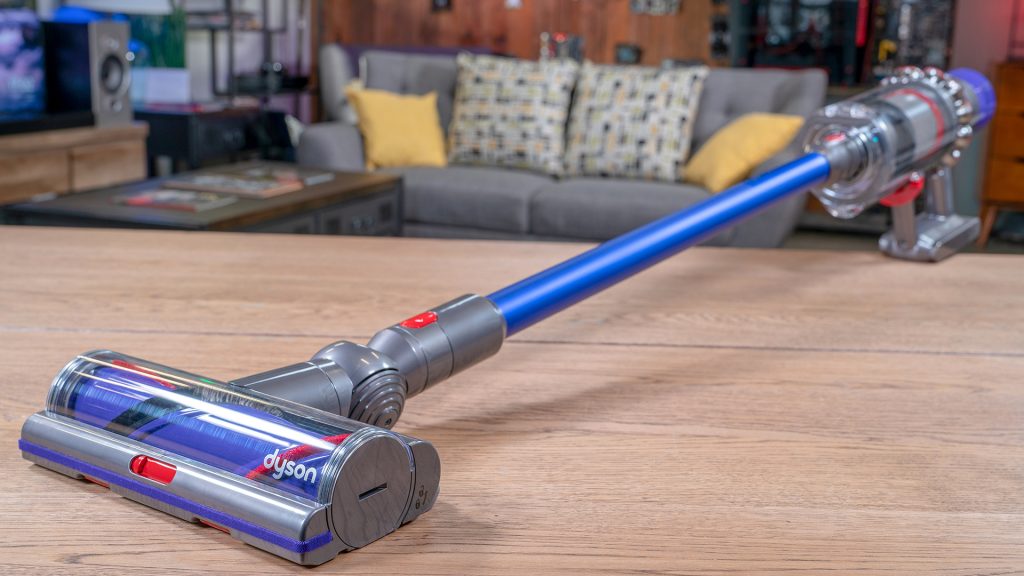
Using the Dyson Cyclone V10 Absolute was something of a revelation for me. I used a stick vacuum only once before this review, back when I worked retail and had to clean my department’s floors at the end of the night. The stick vac we used gained the reputation as the one you took only if the other “real” vacuums were in use, as it could barely pick up anything and lasted all of five minutes. To go from that to the full-size-vacuum-beating performance of the V10 was like a quantum leap. Dyson has stated that it will be devoting the bulk of its future engineering resources to cordless stick vacuums, now that they have finally reached the point of comparable performance to full-size vacs. After using the Dyson Cyclone V10 Absolute, I can say that I welcome our convenient cordless future with open arms.
